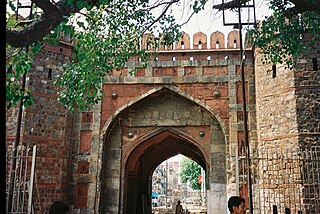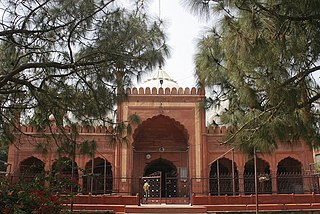
The Walled City of Lahore, also known as the Old City, forms the historic core of the city of Lahore in Punjab, Pakistan. The city was established around 1000 CE in the western half of the Walled City, which was fortified by a mud wall during the medieval era. It is the cultural centre of the Punjab region.
The Chandni Chowk is one of the oldest and busiest markets in Old Delhi, India. It is located close to the Old Delhi Railway Station. The Red Fort monument is located at the eastern end of Chandni Chowk. It was built in the 17th century by the Mughal Emperor, Shah Jahan, and designed by his daughter, Jahanara. The market was once divided by canals to reflect moonlight. It remains one of India's largest wholesale markets.

Masjid-i-Jehan-Numa, commonly known as the Jama Masjid of Delhi, is one of the largest mosques in India.

Mughal architecture is the type of Indo-Islamic architecture developed by the Mughals in the 16th, 17th and 18th centuries throughout the ever-changing extent of their empire in the Indian subcontinent. It developed from the architectural styles of earlier Muslim dynasties in India and from Iranian and Central Asian architectural traditions, particularly Timurid architecture. It also further incorporated and syncretized influences from wider Indian architecture, especially during the reign of Akbar. Mughal buildings have a uniform pattern of structure and character, including large bulbous domes, slender minarets at the corners, massive halls, large vaulted gateways, and delicate ornamentation; examples of the style can be found in modern-day Afghanistan, Bangladesh, India and Pakistan.

The Red Fort or Lal Qila is a historic fort in the Old Delhi neighbourhood of Delhi, India, that historically served as the main residence of the Mughal emperors. Emperor Shah Jahan commissioned construction of the Red Fort on 12 May 1639, when he decided to shift his capital from Agra to Delhi. Originally red and white, its design is credited to architect Ustad Ahmad Lahori, who also constructed the Taj Mahal. The fort represents the peak in the Mughal architecture under Shah Jahan and combines Persian palace architecture with Indian traditions.

Old Delhi is an area in the Central Delhi district of Delhi, India. It was founded as a walled city and officially named Shahjahanabad in 1648, when Shah Jahan decided to shift the Mughal capital from Agra. The construction of the city was completed in 1648, and it remained the capital of Mughal India until its fall in 1857, when the British Empire took over as paramount power in the Indian subcontinent.

The Moti Masjid is a 17th-century mosque inside the Red Fort complex in Delhi, India. It was built by Mughal emperor Aurangzeb, damaged during the Siege of Delhi, and subsequently restored by the British. Named for its white marble, the mosque features ornate floral carvings. It is an important example of Mughal architecture during Aurangzeb's reign.

Delhi has been an important political centre of India as the capital of several empires. The recorded history of Delhi begins with the 8th century Tomar Rajputs kingdom. It is considered to be a city built, destroyed and rebuilt several times, as outsiders who successfully invaded the Indian subcontinent would ransack the existing capital city in Delhi, and those who came to conquer and stay would be so impressed by the city's strategic location as to make it their capital and rebuild it in their own way.

Ustad Ahmad Lahori (c.1580–1649) also known as Ahmad Ma'mar Lahori was the chief Mughal architect and engineer during the reign of emperor Shah Jahan. He was responsible for the construction of several Mughal monuments, including the Taj Mahal in Agra and the Red fort in Delhi; both of which are World Heritage sites. He also designed the Jama Mosque in Delhi.

The Jama Mosque is a 17th-century congregational mosque located in the historic core of Agra, Uttar Pradesh. It was built by Jahanara Begum, the eldest daughter of Mughal Emperor Shah Jahan, during the latter's reign. It is the principal mosque in the city of Agra, and lies close to Agra Fort.

The Fatehpuri Mosque is a 17th-century mosque in India located at the western end of the oldest street of Chandni Chowk, in the Old Delhi neighbourhood of Delhi, India. It is opposite the Red Fort on the opposite end of Chandni Chowk.

Lala Chunnamal Ki Haveli is a rare haveli surviving in a well-preserved condition within the Old Delhi area.

Delhi Gate of Naman is the southern gate in the historic walled city of Delhi, or Shahjahanabad in 1638 AD. The gate links the New Delhi city with the old walled city of Delhi. It stands in the middle of the road, at the end of Netaji Subhash Chandra Road, at the edge of Daryaganj.

Khirki Mosque, approached from the Khirki Village in South Delhi and close to the Satpula or the seven arched bridge on the edge of southern wall of Jahanpanah, was a mosque built by Khan-i-Jahan Junan Shah, the prime minister of Feroz Shah Tughlaq (1351–1388) of the Tughlaq Dynasty. The word 'Khirki' prefixed to mosque is an Urdu word that means "window" and hence is also called "The Mosque of Windows".

The Gates of Delhi were city gates at various medieval townships around Delhi, built under dynastic rulers in the period that could be dated from the 8th century to the 20th century. They are the gates in:
Izz-un-Nissa Begum was the third wife of the Mughal emperor Shah Jahan. She is popularly known by the title, Akbarabadi Mahal, and commissioned the Akbarabadi Mosque in Shahjahanabad. Less commonly, she is also referred to as Sirhindi Begum.

Shalimar Bagh also known as Shalimar Garden is a Mughal garden located on the banks of Yamuna river in Delhi, India. It was named as Aizzabad Bagh when the garden was laid by Izz-un-Nissa wife of Mughal emperor Shah Jahan in 1653 as a tribute and replica of Shalimar Bagh, Kashmir, laid by erstwhile Mughal emperor Jahangir in 1619, the Shalimar Bagh of Delhi is now abandoned but still houses shade trees, majestic parterre and structure such as the Sheesh Mahal and the garden pavilion.

The Zeenat-ul-Masajid, also written as Zeenat-ul-Masjid and popularly known as the Ghata Masjid, is an 18th-century Mughal mosque located in Delhi, India. The mosque was commissioned by Zeenat-un-Nissa, second daughter of the Mughal emperor Aurangzeb.

Madrasa Ghaziuddin Khan is a historical madrasa complex located by the Ajmeri Gate in Old Delhi, India. It was founded around the 18th century by Ghaziuddin Khan I, a leading noble of the Mughal empire. Following the discontinuation of its original function as a madrasa, it successively housed colonial-era educational institutions, such as Delhi College and the Anglo-Arabic school. Today, the Zakir Husain Delhi College operates in its premises, making the madrasa the oldest continuing educational centre in the city of Delhi.
















